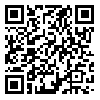Volume 21, Issue 2 (7-2025)
J Health Syst Res 2025, 21(2): 131-143 |
Back to browse issues page
Research code:
Download citation:
BibTeX | RIS | EndNote | Medlars | ProCite | Reference Manager | RefWorks
Send citation to:



BibTeX | RIS | EndNote | Medlars | ProCite | Reference Manager | RefWorks
Send citation to:
Ghahramany M, Peyman N, Afzalaghaee M. A Systematic Review of Childbearing Interventions in Iran: An Analysis Based on the Application of Health Education and Health Promotion Models and Theories. J Health Syst Res 2025; 21 (2) :131-143
URL: http://hsr.mui.ac.ir/article-1-1703-en.html
URL: http://hsr.mui.ac.ir/article-1-1703-en.html
1- PhD Student, Department of Health Education and Health Promotion, School of Health AND Social Determinants of Health Research Center, Mashhad University of Medical Sciences, Mashhad AND Social Determinants of Health Research Center, Gonabad University of Medical Sciences, Gonabad, Iran
2- Professor, Department of Health Education and Health Promotion, School of Health AND Social Determinants of Health Research Center, Mashhad University of Medical Sciences, Mashhad, Iran
3- Associate Professor, Department of Statistics and Epidemiology, School of Health AND Social Determinants of Health Research Center, Mashhad University of Medical Sciences, Mashhad, Iran
2- Professor, Department of Health Education and Health Promotion, School of Health AND Social Determinants of Health Research Center, Mashhad University of Medical Sciences, Mashhad, Iran
3- Associate Professor, Department of Statistics and Epidemiology, School of Health AND Social Determinants of Health Research Center, Mashhad University of Medical Sciences, Mashhad, Iran
Abstract: (1758 Views)
Background: The need for educational programs related to childbearing is a universal concept that has gained significant attention. Especially, in recent decades that the rapid decline in the total fertility rate in Iran has created serious demographic challenges, these programs can assist couples in facilitating the decision-making process regarding childbearing and in designing and implementing pregnancy plans. The primary question of this study is whether the existing research on the application of health education models and theories in childbearing intervention studies demonstrates sufficient maturity.
Methods: The present study utilized all Iranian research studies (both Persian and English) from various databases, including domestic sources [Magiran, Scientific Information Database (SID)] and foreign sources (Web of Science, Scopus, PubMed, ScienceDirect), as well as the Google Scholar search engine, covering the period from the beginning to the end of 2023.
Findings: Among the 3693 reviewed articles, 8 articles were identified as relevant to the purpose of the study. The most frequently utilized theory, appearing in 7 articles, was the Theory of Planned Behavior, which demonstrated effectiveness in influencing women's fertility intentions in 6 of those articles. Another article employed a transtheoretical model, which significantly impacted women's fertility decision-making. Except for one study, all others focused exclusively on women as the target population.
Conclusion: The application of health education theories and models can significantly influence individuals' intentions regarding fertility and their informed decisions about having children, thereby enhancing the effectiveness of training programs. However, the variety and application of these theories in interventional studies related to childbearing have been quite limited. Additionally, the crucial role of men has often been overlooked in the design of educational interventions for childbearing, which should be a primary focus for health researchers
Methods: The present study utilized all Iranian research studies (both Persian and English) from various databases, including domestic sources [Magiran, Scientific Information Database (SID)] and foreign sources (Web of Science, Scopus, PubMed, ScienceDirect), as well as the Google Scholar search engine, covering the period from the beginning to the end of 2023.
Findings: Among the 3693 reviewed articles, 8 articles were identified as relevant to the purpose of the study. The most frequently utilized theory, appearing in 7 articles, was the Theory of Planned Behavior, which demonstrated effectiveness in influencing women's fertility intentions in 6 of those articles. Another article employed a transtheoretical model, which significantly impacted women's fertility decision-making. Except for one study, all others focused exclusively on women as the target population.
Conclusion: The application of health education theories and models can significantly influence individuals' intentions regarding fertility and their informed decisions about having children, thereby enhancing the effectiveness of training programs. However, the variety and application of these theories in interventional studies related to childbearing have been quite limited. Additionally, the crucial role of men has often been overlooked in the design of educational interventions for childbearing, which should be a primary focus for health researchers
Type of Study: Research |
Subject:
education health and promotion
Received: 2023/12/4 | Accepted: 2024/08/4 | Published: 2025/07/6
Received: 2023/12/4 | Accepted: 2024/08/4 | Published: 2025/07/6
Send email to the article author
| Rights and permissions | |
 |
This work is licensed under a Creative Commons Attribution-NonCommercial 4.0 International License. |







